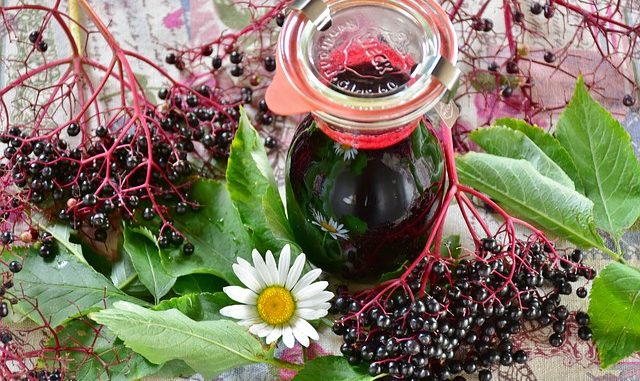
Elderflower or rather elderberry (Sambucus nigra L. Family: Caprifoliaceae) provides not only its flowers but rather appealing purple-black berries too for a distinctive cordial drink. It reminds me of lazy picnics and persistent, annoying wasps attacking the jam spreads. Those particular berries contain a range of anthocyanins, purple pigments with a number of health benefits.
The old Austrian saying is “Tip your hat to the elder.” The saying acknowledges the value ascribed by Europeans generally to the elder with its berries. Elderberries have seen long service in Northern European folk culture as medicine for many complaints and maladies from arthritis and asthma to colds and constipation. In 400 B.C., the ancient Greek philosopher and father of medicine, Hippocrates called the elder tree his “medicine chest. Elderberry is regularly used as a colour in beverages being adopted by many product developers as an ingredient of choice. Combined with its musky flavour particularly from flowers as well as fruit, it offers potential benefits to many aiming for a natural derivative.
Sensory Notes
The fruity aromas in the berries are mainly 5-C and 7-C aldehydes, β-damascenone, aromatic esters and the fresh grassy notes typically from 6-C alcohols and aldehydes such as hexanal, hexanol and (Z)-3-hexenol.
The juice however has a slightly different aroma profile and is composed of dihydroedulan and , β-damascenone (Jensen et al., 2001). The floral and fruity aromas that make up the flowers are also found in the juice although to slightly differing amounts and formed the basis of a comprehensive study into how sensory quality was influenced by the great variety and complexity of aromas to be found (Kaack et al., 2005; Kaack, 2008). There are over 100 cultivars known and most have been described in terms of aroma. There are 53 aroma compounds so far identified.
Vitamins and minerals
Elderberries contain a range of vitamins; A, B1, B2, B6, B9, C and E), trace elements including Cu, Zn, Fe and minerals such as K, Ca and Mg.
The phytochemicals include carotenoids, phytosterols and polyphenols.
Antioxidant Activity
The purple berries contain anthocyanins with antioxidant activity on a par with those in blackcurrants and aronia.
Elderberries Can Help Boost The Immune System Especially Where Colds and Flu Are Concerned
Elderberry fruit extracts are used to support other medicines in cold and flu remedies as well as having benefits as a general immunity booster.
Elderberry supplementation helps reduce the length and irritating symptoms of colds. Not only has this been a traditional use, a few clinical and observational studies on the berry extract with other agents have been examined for efficacy. Air travel places great stress on passenger health and respiratory complaint is a very common occurrence.
In one study with 312 economy class air travellers, they were requested to take a defined quantity of the fruit 10 days before travelling and four or five days following their arrival overseas (Tiralongo et al., 2016). The general result was to experience a reduction by 2 days in the duration of their colds, especially the symptoms of cold.
Reduces Sinus And Respiratory Complaints Other Then Flus And Cold
Sinus infections are tackled by taking lozenges containing elderberry.
Many fruits rich in anthocyanins, polyphenols and other phytochemicals have a broad spectrum of pharmacological activity especially in cancer cell studies. Elderberry fruit extracts are often combined with other fruit materials as in the OptiBerry product range (Bagchi et al., 2006).
If you are interested in the special properties of the elderflower then read the corresponding article.
References
Bagchi, D., Roy, S., Patel, V. et al. Mol Cell Biochem (2006) 281: 197. https://doi.org/10.1007/s11010-006-1030-6
Jensen, K., Christensen, L. P., Hansen, M., Jørgensen, U., Kaack, K. (2001) Olfactory and quantitative analysis of volatiles in elderberry (Sambucus nigra L.) juice processed from seven cultivars. J. Sci. Food Agric. 81, pp. 237-244.
Kaack, K. (2008) Aroma composition and sensory quality of fruit juices processed from cultivars of elderberry (Sambucus nigra L.). Eur. Food Res., Technol., 227 pp. 45-56
Kaack, K., Christensen, L.P., Hughes, M. Eder, R. (2005) The relationship between sensory quality and volatile compounds in raw juice processed from elderberries (Sambucus nigra L.). Eur. Food Res. Technol., 221 (3-4) pp. 244-254
Tiralongo, E., Wee, S.S., Lea, R.A. (2016) Elderberry Supplementation Reduces Cold Duration and Symptoms in Air-Travellers: A Randomized, Double-Blind Placebo-Controlled Clinical Trial. Nutrients. 8(4):182. doi:10.3390/nu8040182.

Did you ever find any product development news?
I have and organic farm and we’re considering production.
thanks
Just went out and picked the first elderflowers of the new season (don’t panic, I live in Italy where the season is more advanced than in the UK!). Last year I tried a version in which the flowers, zest, lemon juice and (cold) water are left to sit for three days in the sunshine, then strained, the sugar added and the whole thing boiled up and left to simmer for a couple of minutes before bottling. Unlike most of the recipes in which the boiling happens before the steeping, this version also keeps well OUT of the fridge, and I only finished the last bottle about a month ago. Elle !